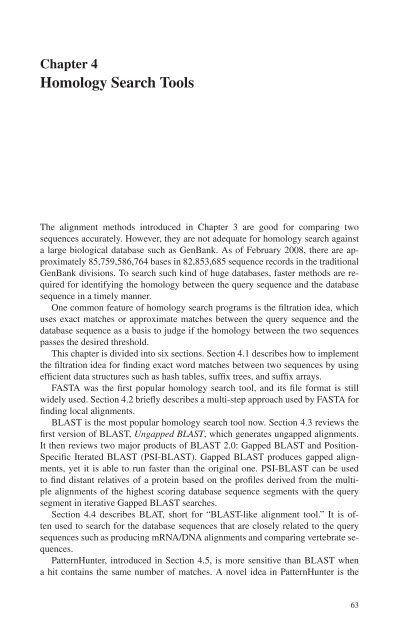Create successful ePaper yourself
Turn your PDF publications into a flip-book with our unique Google optimized e-Paper software.
Chapter 4<br />
Homology Search Tools<br />
The alignment methods introduced in Chapter 3 are good for comparing two<br />
sequences accurately. However, they are not adequate for homology search against<br />
a large biological database such as GenBank. As of February 2008, there are approximately<br />
85,759,586,764 bases in 82,853,685 sequence records in the traditional<br />
GenBank divisions. To search such kind of huge databases, faster methods are required<br />
for identifying the homology between the query sequence and the database<br />
sequence in a timely manner.<br />
One common feature of homology search programs is the filtration idea, which<br />
uses exact matches or approximate matches between the query sequence and the<br />
database sequence as a basis to judge if the homology between the two sequences<br />
passes the desired threshold.<br />
This chapter is divided into six sections. Section 4.1 describes how to implement<br />
the filtration idea for finding exact word matches between two sequences by using<br />
efficient data structures such as hash tables, suffix trees, and suffix arrays.<br />
FASTA was the first popular homology search tool, and its file format is still<br />
widely used. Section 4.2 briefly describes a multi-step approach used by FASTA for<br />
finding local alignments.<br />
BLAST is the most popular homology search tool now. Section 4.3 reviews the<br />
first version of BLAST, Ungapped BLAST, which generates ungapped alignments.<br />
It then reviews two major products of BLAST 2.0: Gapped BLAST and Position-<br />
Specific Iterated BLAST (PSI-BLAST). Gapped BLAST produces gapped alignments,<br />
yet it is able to run faster than the original one. PSI-BLAST can be used<br />
to find distant relatives of a protein based on the profiles derived from the multiple<br />
alignments of the highest scoring database sequence segments with the query<br />
segment in iterative Gapped BLAST searches.<br />
Section 4.4 describes BLAT, short for “BLAST-like alignment tool.” It is often<br />
used to search for the database sequences that are closely related to the query<br />
sequences such as producing mRNA/DNA alignments and comparing vertebrate sequences.<br />
PatternHunter, introduced in Section 4.5, is more sensitive than BLAST when<br />
a hit contains the same number of matches. A novel idea in PatternHunter is the<br />
63

















